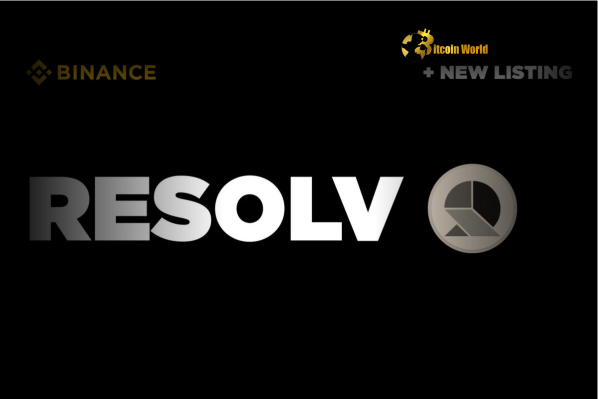BitcoinWorld

Project Crypto: Revolutionizing US Markets for an On-Chain Future
The financial world is abuzz with a groundbreaking initiative set to redefine how markets operate. The U.S. Securities and Exchange Commission (SEC) has officially launched Project Crypto, a monumental endeavor aimed at modernizing securities regulations and paving the way for a seamless transition of U.S. financial markets to advanced on-chain systems. This isn’t just another regulatory update; it’s a strategic move designed to secure America’s position as a global leader in the rapidly evolving digital asset landscape. But what exactly does Project Crypto entail, and how will it reshape the future of finance as we know it?
Unveiling Project Crypto: A New Era for US Finance
The announcement came directly from U.S. SEC Chair Paul Atkins, signaling a clear intent from the highest levels of financial regulation to embrace the potential of blockchain technology. Project Crypto is more than just a name; it’s a comprehensive initiative built upon the robust recommendations outlined in a pivotal report from the President’s Working Group on Digital Assets. This foundation ensures that the project is not a knee-jerk reaction but a well-thought-out strategy, aligning with broader governmental goals for innovation and economic growth.
Atkins emphasized that the SEC will not embark on this journey alone. A crucial element of Project Crypto involves close collaboration with the SEC’s dedicated Crypto Task Force, a specialized unit spearheaded by the well-known Commissioner Hester Peirce. Peirce, often dubbed “Crypto Mom” for her progressive stance on digital assets, brings invaluable insight and a forward-thinking perspective to the regulatory body. This partnership is vital for ensuring that the proposed changes are not only legally sound but also technologically informed and practically implementable.
The overarching ambition, as reported by The Block, is clear: to solidify the U.S. as the undisputed global leader in crypto innovation and capital markets. This involves creating a regulatory environment that fosters growth and adoption while simultaneously safeguarding investors and maintaining market integrity. It’s a delicate balance, but one that Project Crypto aims to strike with precision.
Why the On-Chain Transition Matters: Benefits of Project Crypto
The move towards on-chain financial systems represents a paradigm shift with profound implications. The traditional financial infrastructure, while robust, often suffers from inefficiencies, opaqueness, and high costs. On-chain systems, powered by blockchain technology, offer compelling solutions. Here are some of the key benefits that Project Crypto seeks to unlock:
- Enhanced Efficiency and Speed: Transactions on a blockchain can be processed much faster and often at a lower cost than traditional methods, eliminating intermediaries and reducing settlement times. Imagine instantaneous settlement for securities, rather than days.
- Increased Transparency: Blockchain’s immutable ledger provides a transparent record of all transactions, enhancing auditability and reducing opportunities for fraud. This builds greater trust within the market.
- Improved Accessibility and Inclusion: On-chain systems can potentially lower barriers to entry for a wider range of participants, democratizing access to financial services and investment opportunities.
- Greater Security: The cryptographic nature of blockchain offers enhanced security features, making it incredibly difficult to tamper with records once they are on the chain.
- Reduced Operational Costs: Automation through smart contracts can streamline complex processes, leading to significant cost savings for financial institutions.
By facilitating this transition, Project Crypto aims to build a more resilient, efficient, and equitable financial system for the 21st century.
Navigating the Waters: Challenges and Considerations for Project Crypto
While the vision for Project Crypto is ambitious and promising, the path to a fully on-chain financial market is not without its hurdles. The SEC and its Crypto Task Force will need to address several complex challenges to ensure a smooth and secure transition:
- Regulatory Clarity and Harmonization: One of the biggest challenges in the digital asset space has been the lack of clear and consistent regulation. Project Crypto must provide definitive guidelines for how existing securities laws apply to on-chain assets and create new frameworks where necessary, while also seeking to harmonize with international standards.
- Technological Infrastructure and Scalability: Building and integrating robust on-chain infrastructure capable of handling the immense volume and complexity of U.S. financial markets is a monumental task. Scalability, interoperability between different blockchains, and cybersecurity will be paramount.
- Investor Protection and Market Integrity: Ensuring that investors are adequately protected in a novel on-chain environment is central to the SEC’s mandate. This includes addressing issues like market manipulation, rug pulls, and ensuring fair disclosure in a decentralized context.
- Education and Adoption: Both financial institutions and the general public will require significant education to understand and adopt these new systems. Resistance to change, lack of technical expertise, and skepticism could hinder widespread adoption.
- Data Privacy and Compliance: While transparency is a benefit, ensuring compliance with data privacy regulations (like GDPR or CCPA) in a publicly viewable blockchain environment presents unique challenges that need innovative solutions.
Successfully navigating these complexities will be crucial for the long-term success and impact of Project Crypto.
Real-World Impact: How Project Crypto Could Reshape Industries
The implications of a successful on-chain transition facilitated by Project Crypto extend far beyond just the trading of cryptocurrencies. Imagine a future where:
- Tokenized Real Estate: Property ownership is represented by digital tokens on a blockchain, making real estate investments more liquid, fractional, and accessible to a broader range of investors. Transfers could happen almost instantly, reducing legal fees and administrative burdens.
- Streamlined Supply Chains: On-chain smart contracts could automate payments and verifications throughout complex supply chains, increasing efficiency, reducing fraud, and providing real-time transparency for goods from origin to consumer.
- Efficient Bond Markets: Issuance and trading of corporate and government bonds could be entirely on-chain, leading to faster settlement, lower costs, and greater transparency for all participants.
- Democratized Private Equity: Smaller investors could gain access to private equity and venture capital opportunities through tokenized funds, previously reserved for institutional players.
These are just a few examples of how Project Crypto could catalyze innovation across various sectors, creating new economic opportunities and fundamentally changing how value is exchanged.
Actionable Insights for Stakeholders: Preparing for the On-Chain Future with Project Crypto
The launch of Project Crypto signals a clear direction for the U.S. financial landscape. For various stakeholders, this means it’s time to prepare:
| Stakeholder Group | Key Actionable Insight |
|---|---|
| Traditional Financial Institutions | Begin exploring blockchain technology, investing in talent, and forming partnerships with crypto-native firms. Understand how existing products can be tokenized. |
| Crypto Innovators & Startups | Engage actively with regulatory bodies. Focus on building compliant, scalable solutions that address real-world financial challenges within the evolving framework of Project Crypto. |
| Investors (Retail & Institutional) | Stay informed about regulatory developments. Understand the risks and opportunities of tokenized securities and on-chain assets. Seek advice from regulated professionals. |
| Policy Makers & Regulators (Beyond SEC) | Collaborate to ensure a holistic and harmonized approach to digital asset regulation across different agencies and jurisdictions. |
The time for passive observation is over. Active engagement and proactive planning will be key to thriving in the new financial paradigm shaped by Project Crypto.
The Road Ahead: What’s Next for Project Crypto?
The journey for Project Crypto is just beginning. The SEC’s collaborative approach with its Crypto Task Force, led by Commissioner Hester Peirce, indicates a commitment to thoughtful and iterative development. We can expect to see:
- Public Consultations and Feedback: The SEC will likely seek extensive public input from industry participants, academics, and consumer advocates to refine its proposals.
- Pilot Programs and Sandboxes: To test new regulatory frameworks and technologies in a controlled environment before widespread implementation.
- Ongoing Research and Analysis: Continuous monitoring of market developments, technological advancements, and international regulatory trends to ensure the project remains agile and effective.
The success of Project Crypto will not only depend on the SEC’s efforts but also on the willingness of the broader financial ecosystem to adapt, innovate, and collaborate towards a more modern, efficient, and secure future.
In conclusion, the launch of Project Crypto by the U.S. SEC marks a pivotal moment in the evolution of global finance. It signifies a clear recognition of the transformative power of on-chain systems and a proactive step towards integrating them into the core of U.S. capital markets. While challenges remain, the commitment from the SEC, coupled with the expertise of its Crypto Task Force, paints a hopeful picture for a future where financial transactions are faster, more transparent, and accessible to all. This initiative is not merely about regulation; it’s about fostering innovation, ensuring investor protection, and solidifying America’s leadership in the digital age. The on-chain transition is no longer a distant possibility; with Project Crypto, it’s becoming a tangible reality.
Frequently Asked Questions (FAQs)
Q1: What is Project Crypto?
A1: Project Crypto is a new initiative launched by the U.S. SEC, announced by Chair Paul Atkins, aimed at modernizing securities regulations to support the transition of U.S. financial markets to on-chain systems using blockchain technology.
Q2: Who is leading the SEC’s efforts on Project Crypto?
A2: SEC Chair Paul Atkins announced the initiative, and the SEC will collaborate closely with its Crypto Task Force, which is led by Commissioner Hester Peirce.
Q3: What are the main goals of Project Crypto?
A3: The primary goals include modernizing securities regulations, facilitating the shift to on-chain financial markets, enhancing market efficiency and transparency, ensuring investor protection, and establishing the U.S. as a global leader in crypto innovation.
Q4: How will Project Crypto benefit financial markets?
A4: It is expected to bring benefits such as increased efficiency and speed in transactions, greater transparency, improved accessibility, enhanced security, and reduced operational costs through the adoption of on-chain systems.
Q5: What challenges might Project Crypto face?
A5: Key challenges include achieving regulatory clarity and harmonization, building robust technological infrastructure, ensuring comprehensive investor protection, fostering widespread adoption, and addressing data privacy concerns in an on-chain environment.
If you found this article insightful, consider sharing it with your network! Help us spread the word about the exciting developments shaping the future of finance.
To learn more about the latest crypto market trends, explore our article on key developments shaping digital assets’ institutional adoption.
This post Project Crypto: Revolutionizing US Markets for an On-Chain Future first appeared on BitcoinWorld and is written by Editorial Team





